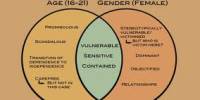The process of combining two cultures to form a new culture is referred to as cultural amalgamation. It is frequently defined as a more balanced sort of cultural contact than cultural assimilation. It refers to the process through which different cultures come into touch and interact with one another, resulting in the mixing and integration of their cultural aspects, customs, and traditions. It is also known as cultural fusion or cultural blending.
Cultural amalgamation does not involve one group’s culture affecting the culture of another group (acculturation) or one group adopting the culture of another group (assimilation). This can occur through a variety of channels, including trade, migration, colonialism, intermarriage, and the sharing of ideas and technologies. Instead, a new culture is formed. This is the beginning of cultural fusion. It is the equivalent to the melting pot theory. As a result of cultural amalgamation, new cultural expressions, beliefs, customs, and identities may emerge.
Cultural amalgamation is a concept that is frequently used in studies on the post-civil rights era in the United States, as well as modern multiculturalism and multiracialism. For example, after the fall of the Roman Empire, the process of cultural amalgamation began, and Roman Jewish/Christian civilization and Germanic tribal cultures merged on the European continent. Cultural fusion occurs today as a result of immigration.
Key aspects of cultural amalgamation include:
- Cultural Exchange: Different cultures interact through trade, travel, or other forms of contact, leading to the exchange of goods, ideas, and cultural practices.
- Hybridization: Cultures blend together, often creating hybrid or mixed forms of culture. This can be seen in language, cuisine, art, fashion, and more.
- Acculturation: One culture may adopt certain elements from another culture, which can be either forced or voluntary. This may result in the assimilation of some cultural practices.
- Syncretism: The merging of religious or spiritual beliefs and practices from different cultures. Often, this leads to the creation of new belief systems or religious practices.
- Cultural Diversity: While cultural amalgamation can lead to the blending of cultures, it can also celebrate and preserve cultural diversity as various elements coexist and interact.
The Silk Road trade routes connecting East and West, which fostered the interchange of products and ideas between Asia and Europe, are examples of historical cultural fusion. As a result, technologies, religions, and cultural practices spread.
Cultural fusion is still happening in the current world, especially in multicultural communities where individuals from many cultural backgrounds live and interact. Diverse cultural aspects merge and contribute to the complex fabric of current culture in various situations.
















